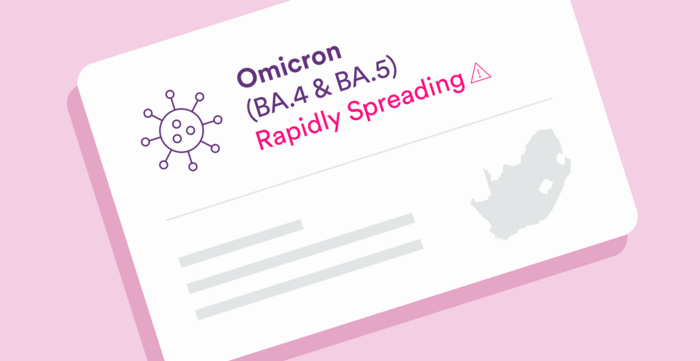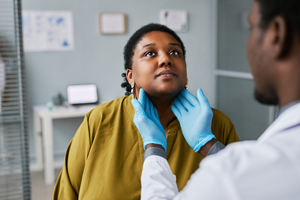Key points
- Omicron BA.4 and BA.5 are the dominant COVID-19 strains in the US, spreading faster than previous variants.
- These variants evade natural immunity and vaccine protection, leading to a surge in cases globally.
- Current vaccines and boosters are less effective against BA.4 and BA.5, but still offer protection against severe disease.
- Moderna is developing a booster shot to combat these variants, with hopes of approval by Fall 2022.

Another day, another COVID-19 variant in the news — at least that’s what it feels like these days. This time around, there are two variants of concern in the spotlight: Omicron BA.4 and BA.5. Together, both sub-variants are now the dominant strains of coronavirus in the United States, according to CDC data. Experts are monitoring the two variants after a surge in cases and hospitalizations in South Africa, Europe, and the UK.
It can be exhausting to keep up with new variants as we attempt to return to our pre-pandemic lives. But a virus does what a virus does — it mutates to evade our immune responses. So, staying informed is important to protect yourself and your loved ones.
So, here are more details on what we know about BA.4 and BA.5.
How fast do BA.4 and BA.5 spread?
BA.4 and BA.5 seem to spread faster than all other COVID counterparts, including their immediate predecessor, Omicron BA.2. CDC data shows that BA.4 and BA.5 are now the dominant strains in the US, accounting for 52% of new COVID infections.
Why the surge in BA.4 and BA.5 cases?
The European Centre for Disease Prevention Control (ECDC) estimates that BA.4 and BA.5 spread more rapidly than previous variants because they circumvent natural immunity from prior infections and protection from vaccines. In a letter to the New England Journal of Medicine (NEJM), Harvard researchers agree. Says Dr. Rob Rohatsch, MD, Chief Medical Officer of Solv, “It looks like BA.4 and BA.5 infect even people who were immune to all other COVID variants. It seems to be one reason for the surge in cases around the globe.”
According to the ECDC, preliminary lab data shows that mutations in Omicron BA.4 and BA.5 make them quite different from the original COVID-19 virus and even the recent Omicron sub-variants BA.1 and BA.2. This may be why vaccinations developed with earlier COVID versions in mind may not be as effective.
What are the symptoms of Omicron BA.4 and BA.5 infections? How serious are they?
On the plus side, Omicron BA.4 and BA.5 infections do not seem to be more severe than other Omicron variants. However, as the ECDC notes, “an increase in COVID-19 cases overall can result in an increase in hospitalizations, ICU admissions, and deaths.”
Dr. Rohatsch adds, “While it is a relief to see that BA.4 and BA.5 are not causing more severe infections, it is important not to dismiss the new strains altogether. Since they seem to circumvent our immunity, the chances of re-infections are more. And the risk of reinfection is higher when antibody immunity wanes.”
Apart from the unpleasantness of being sick, there is the risk of developing long Covid, even for vaccinated individuals. A CDC study of millions of cases shows that 1 in 4 adults over 65 had at least one symptom of long Covid even a year after the initial Covid infection. The number is 1 in 5 for adults under 65. Long Covid symptoms include pulmonary embolism, respiratory issues, muscle pain, and more.
You may be wondering what all this information means for you, specifically. If so, consider speaking with a medical professional to help you decide what you can do to protect yourself and your loved ones. With Solv, you can video chat with an amazing US-based provider in as little as 15 minutes.
Do existing vaccines and boosters protect against Omicron BA.4 and BA.5?
The real answer is that current COVID vaccines and boosters are not as effective against BA.4 and BA.5 as they were against previous variants. But experts believe that vaccines do offer protection against severe disease.
Dr. Rohatsch explains, “The bottom line is that it’s best to keep up with your vaccination schedules and stay informed about developments in vaccine research.”
Learn about vaccine availability or find a vaccine on Solv. Solv can also help you book same-day appointments with a physician near you.
What about children and their immunity against BA.4 and BA.5?
Parents want to know: do vaccines for children aged 6 months and up work against BA.4 and BA.5? Since the Omicron variants are relatively new, only time will tell. Pfizer’s data was collected before Omicron hit. Moderna’s vaccine trial occurred when Omicron was dominant, but it’s not clear how well the vaccine protects against the new strains.
Remember, being fully vaccinated and boosted offers protection against severe disease. To learn more, consider talking to a pediatrician or a family physician about the vaccines approved for kids.
Solv can help you schedule a same-day appointment with a provider near you.
Is there a vaccine that works against BA.4 and BA.5?
In the cat-and-mouse game of COVID virus versus vaccines, there may soon be hope. As the COVID virus mutates aggressively to survive, new vaccines are being developed to help keep up - for example, the Moderna bivalent booster.
On June 8th, 2022, Moderna said that their booster shot was designed to fight the Omicron variant along with the original Coronavirus. Their latest clinical trial (not peer-reviewed data) showed that people who received the Moderna bivalent vaccine developed antibodies five times higher than people who were previously vaccinated and infected but did not receive the shot. However, while the antibody response to the original Omicron variant was strong, the response to BA.4 and BA.5 was weaker. Moderna hopes to have the booster approved by Fall 2022.
Since BA.4 and BA.5 are about to become the dominant strains in the US, there is new information being released every day. If you would like to talk to a healthcare professional about your specific medical history, Solv can help you see a doctor near you in less than a day.
Apart from vaccinations, we can help our natural immunity by staying on top of our health. This includes regular annual wellness visits, preventive screenings, exercise, and nutrition.
The views expressed by authors and contributors of such content are not endorsed or approved by Solv Health and are intended for informational purposes only. The content is reviewed by Solv Health only to confirm educational value and reader interest. You are encouraged to discuss any questions that you may have about your health with your healthcare provider.
FAQs
What are the Omicron BA.4 and BA.5 variants?
They are the latest dominant strains of COVID-19 in the US, known for spreading faster and evading natural immunity and vaccine protection.
Are these variants more severe than previous ones?
No, they are not more severe, but due to their rapid spread, there can be an increase in hospitalizations and deaths.
Are current vaccines and boosters effective against these variants?
They are less effective against BA.4 and BA.5 compared to previous variants, but still offer protection against severe disease.
Is there a vaccine in development specifically for these variants?
Yes, Moderna is developing a booster shot to combat these variants, with hopes of approval by Fall 2022.
How do these variants affect children's immunity?
It's unclear how well current vaccines for children protect against these new strains. However, being fully vaccinated offers protection against severe disease.
How effective are vaccines for children against BA.4 and BA.5?
It's not yet clear how well vaccines for children aged 6 months and up work against BA.4 and BA.5. Since the Omicron variants are relatively new, more data is needed to determine their effectiveness.
Is there a vaccine that works against BA.4 and BA.5?
New vaccines are being developed to keep up with the mutating COVID virus. For example, Moderna's bivalent booster was designed to fight the Omicron variant along with the original Coronavirus. However, while the antibody response to the original Omicron variant was strong, the response to BA.4 and BA.5 was weaker.
What can individuals do to protect themselves from BA.4 and BA.5?
Apart from getting vaccinated and boosted, individuals can help their natural immunity by staying on top of their health. This includes regular annual wellness visits, preventive screenings, exercise, and nutrition. It's also important to stay informed about developments in vaccine research.









